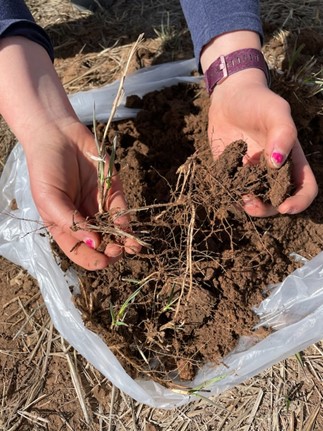Regenerative Agriculture: A Pro-Cattle Approach to Climate Change Mitigation
By Katherine Potter | Articles Editor
December 1, 2023
—
Agriculture touches nearly every element of human life.[1] Despite increased urbanization within the United States,[2] agriculture retains it substantial influence. While four in five United States citizens currently reside, work, or recreate in urban settings, urban land comprises merely 3.6% of domestic land coverage.[3]
The remaining 96.4% of the 2.3 billion acres of United States land is subject to some other type of land management.[4] Forested land constitutes 28% of total United States land use and cropland accounts for 17%.[5] Grassland pasture and rangeland comprise the largest type of land use, totaling nearly one third of United States land management.[6] Combined, the United States uses 897,400,000 acres for farming.[7]
Mismanaged agriculture is a key contributor to global climate change. Conventional agricultural practices like mechanized plowing of the land, grazing animals in stationary paddocks, and monocropping cause soil erosion and land depletion.[8] These practices also pollute water, threaten ecosystems, and increase invasive species.[9] Conventional agriculture is extractive.[10]
The harm that many conventional agricultural practices cause demonstrates the need to shift the agricultural paradigm from the current extractive land management approach to a restorative land management approach. Regenerative agriculture answers this call.[11] Multiple principles of land management define regenerative agriculture, including reducing land tillage, using cover crops, and most importantly, integrating livestock into the land.[12] These principles all aim to achieve regenerative agriculture’s goal of “nourishing” human relationships with the earth.[13] In other words, regenerative agriculture is restorative.
Mismanagement of livestock has fostered widespread anti-livestock sentiment.[14] Public perceptions direct the most negative feelings toward cattle, overshadowing the positive impacts cattle can have on the environment.[15] Managing cattle in accordance with regenerative agriculture—namely integrating them into the land—mitigates soil erosion,[16] increases the resiliency of soils to climate change,[17] and is a fundamental element of grassland health, which is particularly significant considering the prevalence of grasslands in the United States.[18] Most importantly, cattle management that complies with regenerative agriculture increases soil health which sequesters more atmospheric carbon dioxide and substantially mitigates climate change.[19]
To combat the damaging environmental effects of conventional agriculture, law and policymakers should direct more effort to moving the United States away from conventional agriculture and towards regenerative agriculture. The Federal Government is already increasing funding for progressive agricultural programs through its Inflation Reduction Act.[20] The Federal Government should capitalize off this momentum by enhancing its other laws and programs.
On a smaller scale, state lawmakers should work within existing state land-use regimes to mandate changes to livestock management. For example, the state of Colorado’s legislature codified the 1954 Dust Blowing Act.[21] The Act requires Colorado’s landowners and occupiers to fulfill listed obligations—like planting perennial grasses—to prevent soil erosion.[22] The Colorado Legislature should strengthen this list by requiring Coloradans to integrate their cattle into their land. Likewise, other state legislatures should examine their statutory codes and amend those statutes to require that cattle owners integrate their cattle into the land. Shifting states with robust animal agriculture regimes to regenerative agriculture allows cattle to serve as a climate change solution.
[1] See generally, Emily M. Broad Leib et al., The Urgent Call for a U.S. National Food Strategy 7–8 (Esther Akwii et al. eds., 2020) (describing the interrelated impacts of food and agriculture on the environment, economy, and human health during the aftermath of the COVID-19 pandemic).
[2] Daniel P. Bigelow & Allison Borchers, Major Uses of Land in the United States, 2012, U.S. Dep’t. of Agric. (2017), https://www.ers.usda.gov/webdocs/publications/84880/eib-178_summary.pdf?v=4455.7 (noting that urban land increased from by 10 million acres from 2002 to 2012 and increased twice as fast as population increased across most of the 1900s).
[3] Dave Merrill & Lauren Leatherby, Here’s How America Uses Its Land, Bloomberg (2018), https://www.bloomberg.com/graphics/2018-us-land-use/.
[4] Bigelow, supra note 2.
[5] Id.
[6] Id.
[7] Nat’l Agric. Stat. Surv., Farms and Land in Farms 2019 Summary, U.S. Dep’t. of Agric., 4 (2020), https://www.nass.usda.gov/Publications/Todays_Reports/reports/fnlo0220.pdf.
[8] Moises Valasquez-Manoff, Can Dirt Save the Earth?, N.Y. TIMES MAG. (2018), https://www.nytimes.com/2018/04/18/magazine/dirt-save-earth-carbon-farming-climate-change.html.
[9] What are the trends in land use and their effects on human health and the environment?, Env’t. Prot. Agency (October 4, 2022), https://www.epa.gov/report-environment/land-use.
[10] Jenileigh Harris, Managed Rotational Grazing Policies: An Overview of Farm Bill Programs to Support Regenerative Agriculture 6 (Cathy Day et al. eds., 2023).
[11] NRDC, Regenerative Agriculture 101, NRDC (2021), https://www.nrdc.org/stories/regenerative-agriculture-101. While the phrase “regenerative agriculture” has only recently entered public discourse, Indigenous Peoples and Native Americans first stewarded the land. Regenerative agriculture draws significantly from Indigenous knowledge and practices.
[12] Peter Newton et al., What Is Regenerative Agriculture? A Review of Scholar and Practitioner Definitions Based on Processes and Outcomes, 4 Frontiers in Sustainable Food Sys. 1, 5 (2020).
[13] NRDC, supra note 11.
[14] Debra L. Donahue, Livestock Production, Climate Change, and Human Health: Closing the Awareness Gap, 45 Envtl. L. Rep. News & Analysis 11112 (2015) (arguing that “[l]ivestock should be removed from public lands for myriad reasons”).
[15] Alexia Brunet Marks, (Carbon) Farming Our Way Out of Climate Change, 97 Denv. L. Rev. 497, 501–2 (2020); John A. Stanturf, Soils are fundamental to landscape restoration, in Soils and Landscape Restoration 22–3 (John A. Stanturf & Mac A. Callaham Jr. eds., 2020) (describing why misconceptions about cattle causing significant methane emissions and creating desertification are scientifically misdirected).
[16] Shannon Avery Hughes, Global Sustainable Farming and the “SoCo” Soil Conservation Project, 45 Denv. J. Int’l L. & Pol’y 431, 439–40 (2017)
[17] Diana Rodgers & Robb Wolf, Sacred Cow: The Case for (Better) Meat 119 (Claire Schulz, ed., 2020).
[18] Id. (stating that “grasslands need [cattle] to be healthy”).
[19] Marks, supra note 15, at 509.
[20] See generally, Harris, supra note 10, at 8.
[21] Colo. Rev. Stat. § 35-72-101.
[22] Colo. Rev. Stat. § 35-72-102.

